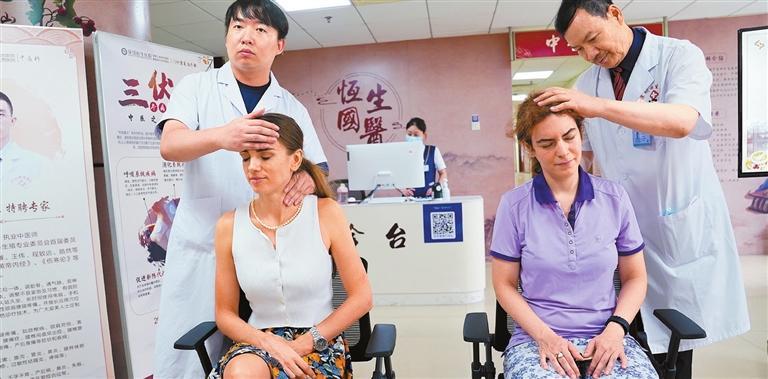
Expat participants at a traditional Chinese medicine (TCM) experience event receive head and neck massages at the TCM clinic of Shenzhen Hengsheng Hospital in Bao’an District yesterday. Wang Haolan
Sachets containing herbs, which help improve sleep and repel mosquitoes, were made by 17 foreign and local participants as they wrapped up their traditional Chinese medicine (TCM) experience at Shenzhen Hengsheng Hospital in Bao’an District yesterday afternoon. The event offered them a brief respite from the intense summer heat during the dog days.
The event was jointly hosted by the Shenzhen Foundation for International Exchange and Cooperation (SFIEC) and the International Health Care Unit (IHCU) of Shenzhen Hengsheng Hospital. It included a TCM lecture, where the participants were introduced to various Chinese herbs with distinct characteristics and medicinal properties. Additionally, the participants engaged in hands-on experiences such as crafting herb sachets, enjoying herbal tea and receiving massage therapy.
German businessman Manfred Appel took the lead in taking a massage therapy specifically targeting his head and neck. “I do massage every week, so I am quite used to it.” Appel said, further elaborating to Shenzhen Daily that his introduction to TCM occurred through a close friend who operates a herbal pharmacy.
“I think we can have more events like this to introduce TCM to more people,” he said. “TCM has distinctive approaches in treating sickness and enhancing overall health of human body, as compared to Western medicine.”
Alka Gupta from India shared her familiarity of trying TCM treatment to cure some throat problems at Nanshan People’s Hospital and stated that she was pleased to participate in the experience event. “I really like the smell of Chinese herbs such as dwarf sweet flag (Acorus gramineus),” she said.
Acorus gramineus, commonly known as Japanese sweet flag or dwarf sweet flag, is a perennial herbaceous plant with a long history of medicinal use in TCM and is primarily known for its ability to promote digestive health and alleviate gastrointestinal discomfort.
When the host called “stop” during the ice-breaking session, Rafiq Ansar from the U.K., holding a sachet in his hand, introduced himself as a “tourist who has traveled to Shenzhen months ago.”
“I wanted to make the most of my stay in Shenzhen, so I followed several official accounts and information portals upon arrival,” Ansar said. “I signed up for this event after seeing it advertised on WeChat.”
“Today’s event was a good introduction to some very important and basic herbs in Chinese medicine,” he said. “We were introduced to Chinese and English (or Latin) names of the herbs and to how they worked on illnesses. We also had some hands-on chance to smell and touch them.”



